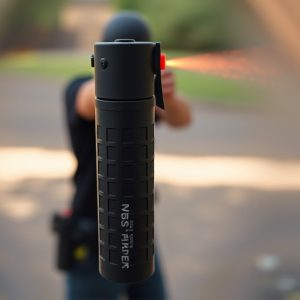Pepper Spray: Legal, Safe Use & Lifesaving Scenarios
Oleoresin capsicum (pepper) spray is a potent self-defense tool derived from chili peppers, effectiv…….
Oleoresin capsicum (pepper) spray is a potent self-defense tool derived from chili peppers, effective against imminent threats. Its safe usage involves careful consideration of threats, clear visibility, aiming at the attacker's face, and proper pressure application. Legal frameworks vary globally, allowing its use primarily as a last resort. Prioritize de-escalation first, follow manufacturer instructions, and ensure proper training to prevent accidental misuse. Adhering to strict handling protocols, including secure storage, appropriate gear, and regular maintenance, ensures safe usage. Pepper spray is a vital tool in diverse settings but should be employed responsibly, only as a last resort against imminent threats, minimizing harm while maximizing protection.
“Discover the power of oleoresin capsicum spray—a non-lethal defense tool that can be a lifesaver in various situations. This comprehensive guide explores the effectiveness and composition of pepper spray, guiding you through legal considerations and safe handling practices. From understanding when it’s legally permissible to use pepper spray to mastering application techniques, we delve into real-world scenarios where this weapon can protect. Additionally, we shed light on potential risks and side effects, emphasizing responsible usage.”
- Understanding Oleoresin Capsicum Spray: Composition and Effectiveness
- When is Pepper Spray Legal to Use? Knowing Your Rights
- Safe Handling and Application Techniques for Optimal Protection
- Common Scenarios Where Pepper Spray Can Be a Lifesaver
- Potential Risks and Side Effects: Using Pepper Spray Responsibly
Understanding Oleoresin Capsicum Spray: Composition and Effectiveness
Oleoresin capsicum spray, often referred to as pepper spray, is a powerful defense tool made from the capsaicin found in chili peppers. Its composition includes a concentration of this compound, along with other ingredients that enhance its effectiveness and stability. When deployed, the spray irritates the eyes, nose, and throat, temporarily disabling an attacker, providing users with crucial time to escape or seek help.
The effectiveness of oleoresin capsicum spray lies in its ability to cause a burning sensation and temporary blindness, often lasting from 20 minutes to an hour. It’s essential to understand that pepper spray is not deadly but can be extremely effective in self-defense scenarios, especially when used properly. When to use it safely involves assessing threats, ensuring the user has clear visibility, aiming for the attacker’s face, and using enough pressure to activate the spray effectively without causing harm to bystanders.
When is Pepper Spray Legal to Use? Knowing Your Rights
Knowing when and where pepper spray is legal to use is crucial for ensuring safety while respecting laws. The legality of carrying and using oleoresin capsicum (OC) spray varies significantly across different countries and regions, with specific rules governing its possession, purchase, and application. In many places, OC spray is permitted for personal defense in situations where an individual feels threatened or their life is in danger. It’s essential to understand the local laws and guidelines, as using pepper spray without legal justification can lead to severe consequences.
When considering when to use pepper spray safely, it’s recommended to act only as a last resort when facing an imminent threat. This means that if you feel your safety or someone else’s is in immediate danger, and all other de-escalation attempts have failed, pepper spray could be a viable tool. Always follow the instructions provided with the device and ensure proper training on its safe use to minimize the risk of accidental discharge or misuse.
Safe Handling and Application Techniques for Optimal Protection
When using oleoresin capsicum spray as a defense tool, safe handling practices are paramount. Always store it in a secure, labeled container out of reach of children and pets. Before deployment, familiarize yourself with the spray’s range, wind conditions, and potential for cross-contamination. Ensure proper ventilation during use to minimize inhalation risks. Dress appropriately, wearing protective clothing that can withstand direct contact with the spray, such as gloves and eye protection.
Application techniques vary based on the scenario, but a consistent approach ensures optimal protection. Maintain a safe distance from the assailant, typically 2–3 meters (6–10 feet), and aim for the face to maximize the spray’s effectiveness. Deactivate or disable the target while they are momentarily incapacitated by the spray. After use, wash affected areas thoroughly with soap and water, and seek medical attention if needed. Regularly inspect and maintain your pepper spray device, ensuring it remains fully charged and in good working condition.
Common Scenarios Where Pepper Spray Can Be a Lifesaver
In various scenarios, having a pepper spray defense tool can be a lifesaver. For instance, during outdoor activities like hiking or camping, individuals might encounter aggressive wildlife or lost their way in remote areas—pepper spray can deter predators and help signal for rescue. In urban settings, it can serve as a deterrent against potential physical assaults, providing users with a non-lethal means to escape dangerous situations swiftly.
When used safely and responsibly, pepper spray is an effective tool for self-defense. It temporarily disables the target by causing severe discomfort and irritation to the eyes, nose, and respiratory system. However, it’s crucial to understand that pepper spray should only be employed as a last resort when facing an imminent threat. Proper training in its use, including awareness of local laws regarding its carrying and application, is essential for ensuring safety and legal compliance.
Potential Risks and Side Effects: Using Pepper Spray Responsibly
When considering pepper spray as a self-defense tool, it’s crucial to understand that its usage is not without potential risks and side effects. While effective in deterring attackers, pepper spray can cause significant discomfort and even more severe reactions in certain individuals. The primary active ingredient, capsaicin, irritates the eyes, nose, and respiratory system, leading to temporary blindness, coughing, and difficulty breathing. Prolonged exposure or direct contact with skin can result in chemical burns.
Therefore, responsible usage is paramount. Pepper spray should only be employed as a last resort when facing an imminent threat. Users must be trained in its correct application, ensuring the spray hits the attacker’s face directly. Proper ventilation is essential during use to minimize inhalation risks. Additionally, regular maintenance and checking of expiration dates are vital to guarantee the product remains effective and safe for use.
Oleoresin capsicum spray, a powerful personal defense tool, offers crucial protection in various high-risk scenarios. However, understanding its legal implications and safe handling practices is essential for responsible use. By knowing when and how to deploy pepper spray, folks can empower themselves while navigating potentially dangerous situations. Remember that, in terms of self-defense, knowledge and preparation are key to ensuring your safety and making informed decisions.


